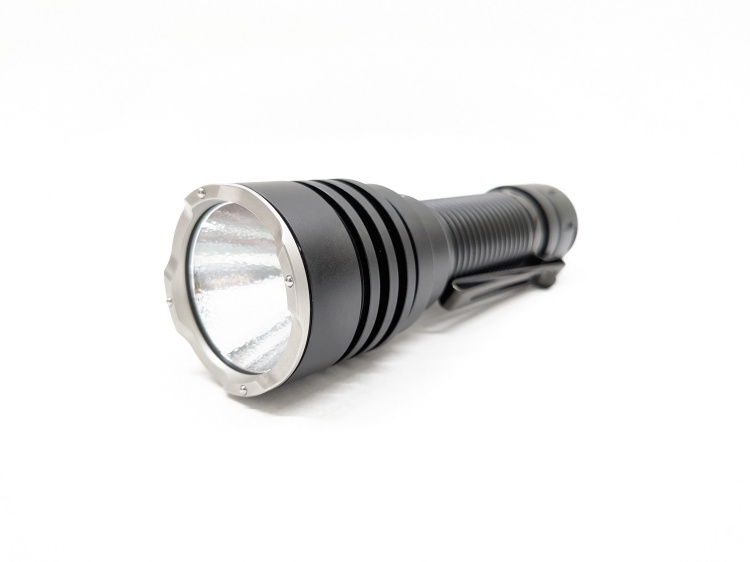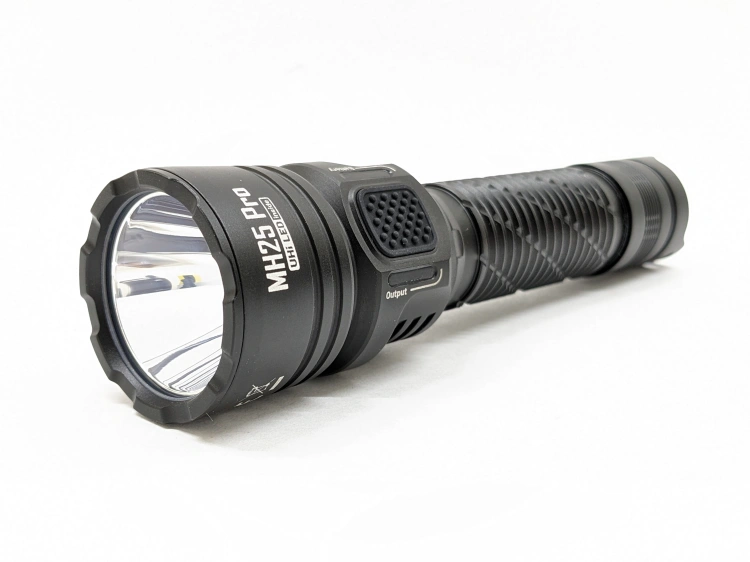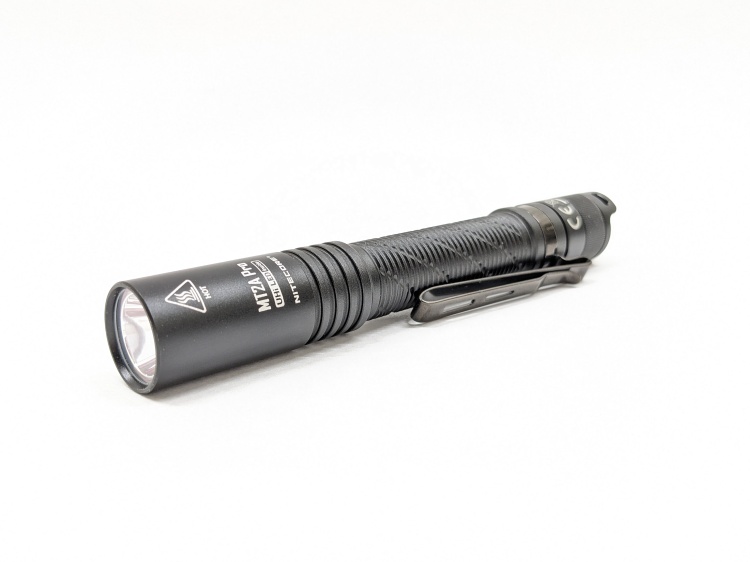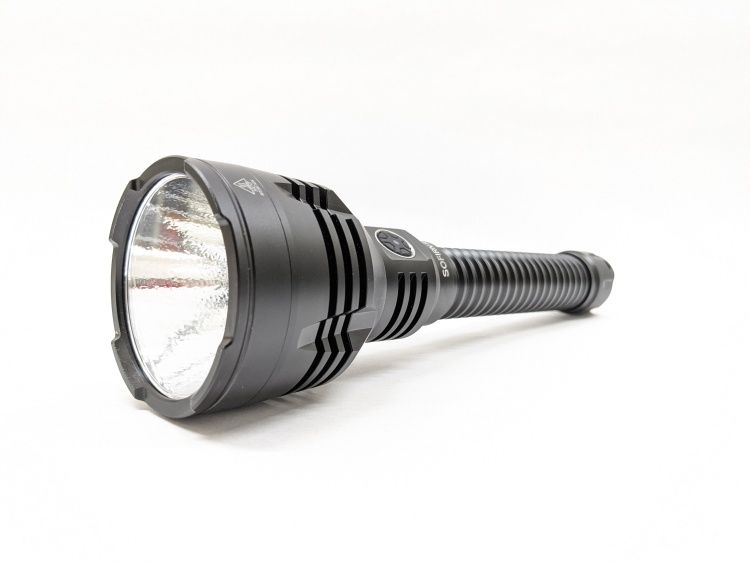Contents
- Pricing & Availability
- What comes in the box?
- Design & Construction
- Size & Measurements
- User Interface
- Emitter & Beam
- Mode Chart
- Runtime
- Driver & Regulation
- Switch
- Carry & Ergonomics
- Batteries & Charging
- Competition
- Conclusion
Pricing & Availability
Wurkkos sent me this light in exchange for an honest review. Here is the official product page where you can see current pricing. If it’s popular enough, they’ll probably list it on Amazon as well.
What comes in the box?
The packaging is much nicer than I expected at this price point. There’s a nice, white, printed sleeve that slides off the box. The box itself is white-wrapped cardboard with a magnetic closure and a foam insert inside to hold everything in place. While it’s nice, I’m sure it’s more expensive than the brown cardboard boxes they’ve used in the past.
- The light itself
- Battery (inside the light)
- User manual
- USB A-to-C charging cable
- Wrist lanyard
- Spare o-rings
Design & Construction
The design is nice with a little bit of “tactical” styling but not too much. It looks similar to an Acebeam L19 2.0, but still looks very “Wurkkos”. I appreciate the relatively minimal branding, especially compared to the ESKilhunTE H150 I reviewed last. It’s nice that the “HOT” warning lines up with the button.

Build quality is satisfactory, as usual from Wurkkos. There are no sharp edges. All the anodizing is smooth and evenly applied. The threads are smooth, square-cut, anodized, and lubricated. I don’t have any complaints but it doesn’t “wow” me like higher-end brands like Olight and Acebeam usually do. The body tube is not reversible.
I want to point out that an image on the product page (shown below) falsely claims that the bezel is stainless steel and shows it breaking glass. The bezel is aluminum and has no glass-breaking functionality.

Size & Measurements
Olight Warrior 3S | Acebeam L19 2.0 | Wurkkos TD01 | Wuben X1 | Acebeam E75

| Measurement | Measured (mm) |
|---|---|
| Bezel Diameter | 58.9 |
| Maximum Head Diameter | 58.9 |
| Length | 154 |
| Side Switch Diameter | 10.5 |
| Side Switch Proudness | 1.3 |
| Tail Switch Diameter | 14.0 |
| Tail Switch Proudness | 2-6.5 |
| Lens Thickness | 2.0 |
| Lens Diameter | 54.7 |
| Optic Diameter | 54.7 |
| Optic Height | 28.3 |
| MCPCB Size | Proprietary |
| Body Tube Diameter (internal) | 22.0 |
| Body Tube Diameter (maximum) | 28.0 |
| Body Tube Diameter (mode) | 27.1 |
| Body Tube Length | 76.1 |
| Tailcap Diameter | 28.5 |
| Tailcap Length | 30.3 |
| Driver Diameter | ~25 |
| USB Port Width | 12.1 |
| USB Port Depth | 3.2 |
| USB Port Height | 11 |
| Included Battery Length | 70.6 |
| Included Battery Diameter | 21.4 |
Weight without battery: 194g
Weight with included battery: 262g
User Interface
The UI has two groups: group 1 is fine for general use and group 2 is good for duty/tactical use.
Mode Group 1:
| State | Action | Result |
|---|---|---|
| Off | Click or Half-Press TS | On (Mode Memory) |
| Off | Hold SS & Click or Half-Press TS | Eco (Not Memorized) |
| Off | Double Half-Press TS | Turbo (Not Memorized) |
| On | Click TS | Off |
| On | Click SS | Cycle Mode (Eco > Low > Med > High) |
| On | Double Click SS | Turbo (Not Memorized) |
| On | Triple Click SS | Strobe (Not Memorized) |
| Strobe | Double Click SS | SOS |
| SOS | Double Click SS | Beacon |
| On | Hold SS (3+ seconds) | Switch Mode Group |
Mode Group 2:
| State | Action | Result |
|---|---|---|
| Off | Click or Half-Press TS | Turbo (No Memory) |
| Off | Hold SS & Click or Half-Press TS | Eco |
| Off | Double Half-Press TS | Strobe |
| On | Click TS | Off |
| On | Click SS | Cycle Mode (Turbo > Med) |
| On | Double Click SS | Strobe (Not Memorized) |
| Strobe | Double Click SS | SOS |
| SOS | Double Click SS | Beacon |
| On | Hold SS (3+ seconds) | Switch Mode Group |
What they got right:
- Clicking turns the light on/off and holding the button changes modes. That’s the way almost all e-switch flashlights should work. It’s intuitive and quick.
- There are 5 brightness levels, which is just the right amount. Enough to have options but not so many that it’s cumbersome to use. In mode group 3 it’s further simplified down to 3 levels.
What they got wrong:
- Too many shortcuts. This is a bit of a personal preference thing, but I think they included way too many shortcuts. The double-tap function in the tailswitch in both mode groups means that I can’t blink it on/off for signalling purposes without shortcutting to Turbo or Strobe. The double-click-Turbo shortcut in the side switch means that I can’t quickly cycle through the modes, I have to do it slowly to not activate the shortcut.,
- There’s a delay in the tailswitch. It’s not huge, probably less than 100 milliseconds, but it’s noticeable and it makes double-tapping for Turbo or Strube somewhat difficult to do consistently. Some people might not notice, but I did, and it bugs me every time I use the light.
Emitter & Beam


TD01 uses a Luminus SFT40 LED in cool white with standard CRI. It’s probably the best single-cell thrower LED available right now so I’m quite pleased with the choice. It’s affordable, easy to drive, bright, and intense. They’ve paired it with a large, plastic, TIR optic which is rare for a light this size.

The beam is very narrow, narrower than I expected. The hotspot is tight with some yellow to the edges. There’s soft, wide, dim spill with no harsh cutoff too. There’s also a big obvious ring. You won’t notice it during most use outside but as soon as you shine it on anything relatively flat and plain like a wall you’ll see it immediately.
In the beamshots below, the concrete corner to the right of the hotspot is 39M away and the power pole in the center is 185M away. There are no comparison shots with Acebeam L19 2.0 because it hadn’t arrived when I took these shots. Their beams are virtually identical so I decided it wasn’t worth going out just to get beamshots of one extra light that looks identical.








Mode Chart
Disclaimer: All of my measurements are taken at turn-on. Lumen measurements were taken on a Texas Ace 3.5″ Lumen Tube. A candela measurement was taken at 10 meters with an Opple Light Master III on the highest brightness, and other candela figures were calculated relative to that. CRI, CCT, & DUV data was taken for each mode from a few feet away at the center of the hotspot with the Opple Light Master and Waveform DUV Calculator. Runtime tests were performed with the Ceilingbounce app on my smartphone. All of these tests were performed with a fully charged included battery unless otherwise specified. I cannot measure moonlight directly, so moonlight readings are calculated based on the brightness relative to the next-lowest mode. None of this is professional equipment, so take all of these measurements with a grain of salt.

Above are the official specs, followed by my own measurements below.
| Level | Lumens | Candela | Throw (Meters) |
| Turbo | 1520 | 300000 | 1095 |
| High | 510 | 100658 | 635 |
| Medium | 170 | 33553 | 366 |
| Low | 89 | 17566 | 265 |
| 19 | 3750 | 122 |
Every mode’s brightness is significantly lower than advertised. However, with optical losses I think it’s performing as it should be so I don’t think it’s under-performing. Rather I think Wurkkos is over-promising. It’s possible they’re quoting the theoretical output at the LED and not the actual out-the-front (OTF) lumens. This has been the case for every TIR thrower I’ve tested (including Acebeam L19 2.0) so it’s par for the course, but I wish these companies would advertise lumens accurately.
Don’t let the lower lumen measurements dissuade you if you’re interested in this light. I measured higher throw numbers than advertised and that’s the more important figure here. TD01 is a thrower after all.
Mode Spacing is good. There are no weirdly small or large jumps. I do wish that Eco mode was an actual sub-lumen Moonlight mode though, as silly as that sounds on a light like this.
Runtime

Performance: Turbo lasts for around a minute before stepping down to 300-500 lumens depending on ambient conditions. That’s pretty poor sustained brightness for a light this size. TD01’s sister light, Sofirn C8L, sustained over 1000lm in my tests.
Thermal regulation: There is some active thermal regulation but it doesn’t make a large difference to Turbo runtime or sustained output. That’s still better than timed stepdowns though.
LVP (Low Voltage Protection): the light will shut off when the battery reaches a critically low level. You can re-activate it briefly in an emergency after shutoff.
Driver & Regulation

There was some confusion around the driver when this light was announced. Someone from Wurkkos said on BLF that it had a “Buck+FET” driver, but I believe that was a mistake or miscommunication. Based on the regulation performance below, this is a FET-only driver with no voltage regulation.

Every mode is heavily and equally affected by the battery voltage, so there is no regulation.
Note: All regulation measurements are taken at turn-on so they do not reflect any thermal or low voltage stepdowns that may occur. A value of 0 indicates low voltage shutoff immediately upon activation.
PWM: No PWM is visible to my eyes, nor audible to my ears, but my smartphone camera was able to pick up some flickering on the middle modes.
Parasitic Drain: There is no parasitic drain because this light uses a mechanical switch.
Switch
TD01 has two switches: a forward clicky mechanical tailswitch that turns the light on and off, and a backlit electronic side switch that controls the brightness level.
The tail switch sits underneath a plush rubber boot and is easy to disassemble with some snap ring pliers. It’s a surprisingly beefy switch for carrying a lot of current, but it feels really cheap to use. The boot is too soft, the switch is too easy to actuate, and there’s a random extra click noise that happens sometimes on my sample. The boot also sticks out past the tailcap wings so it cannot tailstand. There’s a diode on the tailcap PCB to allow charging to happen without the switch being activated.
The side switch has a black plastic boot with a clear window in the center to allow backlighting. It’s got some pre-travel before the click but the click itself feels really crisp and it’s audible. When the light is on, a backlight indicates the battery status through the switch. Green means good charge left, red means a low charge, and flashing red means critically low charge. The backlighting is very bright so you won’t have any trouble seeing it in most lighting conditions. It only stays on for a few seconds after the light is activated.
Carry & Ergonomics
Ergonomics are fairly good. It’s small enough to be held with one hand but large enough that it doesn’t feel cramped. You can’t reach both switches at the same time with one hand very easily but it’s easy to flip around to get to the switch you need. A reverse grip, forward grip, cigar grip, or neck grip all work well.
The only carry method included is a basic wrist lanyard. If you want to carry it on you it will need to be in a bag, belt holster, cargo pocket, or jacket pocket. It’s too large for your average pants pocket.
Batteries & Charging
TD01 uses a single 18650 or 21700 battery. Anything from an unprotected flat top to a protected button top will fit. Wurkkos optionally includes a 5000mah, unprotected, flat-top cell that works just fine and it’s what I used for all my testing. If you use a different battery, just be sure it’s capable of 10a discharge or more to get the best performance on Turbo.

Charging is facilitated by a USB-C port on the side of the head. It’s covered by a rubber flap, which is the same one Wurkkos & Sofirn have been using on larger lights for years. It’s my favorite port cover flap design because it’s very secure but also easy enough to open.
Charging works from A-to-C or C-to-C cables. The light can be used while charging by clicking the side switch, but it’s only medium mode, even with the battery removed. There is no powerbank function.
Competition
Here are some lights in the same class and how they compare.
Sofirn C8L: TD01’s sister light. Made in the same factory with the same overall construction, same switches, same battery, same charging, same UI, and similar size. C8L is significantly brighter, more efficient, and better regulated but it does not throw nearly as far. Similar price.
Acebeam L19 2.0: The premium alternative. Similar size and layout, same LED, similar optic, similar brightness and throw, higher build quality, independent switches, much better efficiency, regulation, and sustained output, much better UI, much better-feeling tail switch. Actual stainless steel bezel. Much more expensive.
Convoy L21B SFT40: Reflector alternative. Similar size, same LED, large reflector instead of TIR, higher brightness, more throw, totally different UI, no integrated charging, no side switch, no battery included, better efficiency and regulation.
This section is not comprehensive. If I didn’t include a particular light here, it doesn’t mean it’s bad or doesn’t deserve to be here. I simply cannot list every possible competitor.
Conclusion
This is the most affordable thrower with a large TIR lens, and that’s important to keep in mind. There are a number of not-so-great things about this light (not meeting lumen specs, poor efficiency, poor regulation, mediocre UI, poor switch feel, switch delay) but it’s so affordable that a lot of those things might not matter to you. You just can’t get a TIR thrower with this many features and this much throw without spending twice as much on another brand! If you’re ok with some of those downsides and are looking to try out a TIR thrower, Wurkkos has built a solid light her for the price and I think it’s a good buy.
Thanks to Wurkkos for sending me this light for review!



























